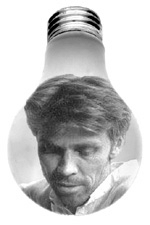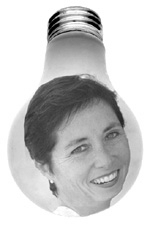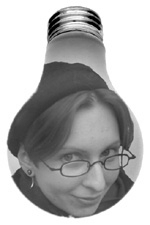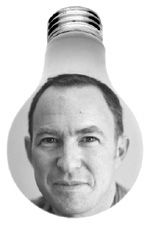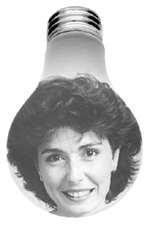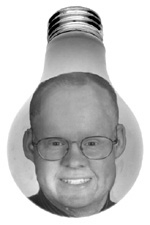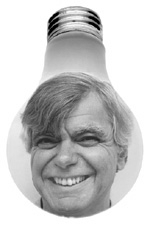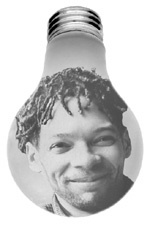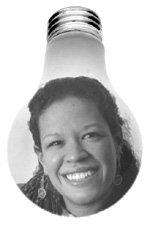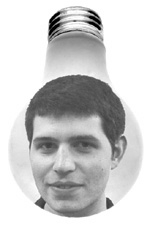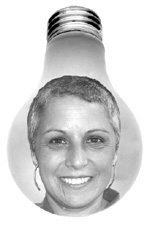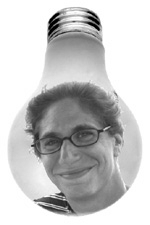Inspired by the List Visual Arts Center's current exhibition, " After the Beginning and Before the End ," Mary Haller of the Office of the Arts invited 12 MIT artists, writers and performers to describe their own creative process.
Francis Doughty
Songwriter/guitarist
Administrative Staff Assistant, Research Laboratory of Electronics
"Inspiration for me ranges widely. It can simply come from the beautiful and exciting sound qualities of the guitar itself or it may be driven by a strong visual image which comes upon me as I'm playing around with a new theme, related motifs and gestures. Other times an episode in life and its attendant mood and feelings will become the inspiration. There are times when I can't recognize the inspiration right away, but as I'm guiding and following the music, there will come a point of recognition and then things start to cohere and flow. That recognition helps everything to fall into place: the moods, the dynamics, melodies, beat patterns, rhythmic gestures, modulations, overall structure, the whole thing."
Laura Harrington
Playwright
Lecturer, Music and Theater Arts
"Whenever I'm asked where I get my inspiration, I quote the playwright, Tom Stoppard: 'If I knew, I'd go there.'
"Lately I feel that my work is created in response to silence--whether it's the silence that overtook my mother as she plummeted into dementia, or the silence surrounding the terrors my father witnessed during World War II. There is something about the mystery of silence that seduces me again and again and makes me want to shout or sing. It's as if the unheralded, the unknown, the voiceless, all speak to me, asking me to give them their hour on stage, to hear their inchoate cry for justice or recognition, or peace."
Whitney Erin Boesel
Writer
Senior, creative writing major
"I find that the creative inspiration behind my plays tends to come from both myself and my characters. When I sit down to begin a play, I generally don't know where the story will end up going; what I have is a few characters, usually sketched from composites of people I know, and a vague premise. After the first pages are written, however, the characters take on personalities, desires and lives all their own--at which point my job as a writer is to watch and listen and let them have their way on the page. Ironically, it's near impossible to win a power struggle with a fictitious character, even one of my own creation; every time I've tried to impose my will on a script, the writing comes out feeling forced and unnatural and I end up rewriting whole scenes on a second or third pass. The characters almost always win in the end; I tend to be the one who has to compromise."
Evan Ziporyn
Composer
Kenan Sahin Distinguished Professor, Music and Theater Arts
"In my experience 'inspiration' is never present tense; it's already happened or I'm still waiting for it. For me, composing is some version of staring into the granite, looking for the sculpture already inside. I try to find a simple, empty starting point--a phrase or a noise that's not particularly interesting, then listen to it, stare at it, play with it, go away from it, listen to it again and again. At some point something will eventually stick in my mind, become interesting, start to suggest possibilities. There's a fair degree of passivity involved in all this, a patience that's always difficult to arrive at. I walk away, the vision gets skewed and the intractable suddenly seems simple. Once that happens it's a lot more fun, impersonal, ego-free. When it's going right (that is, occasionally) it feels like thoughts without a thinker, and it's very nice to escape--even illusorily--from one's inner taskmaster."
Kay Walsh
Visual artist
Administrative Assistant, Center for Environmental Health Sciences
"The things that inspire me are events in my life, and things that I strongly believe in. Recently, I've been hearing truths in my Bible class, and feel compelled to see them visually.
"I do a lot of different kind of art. I have a little 'art basket,' and when I have a project that I'm thinking about or a situation or event I'm working out in my mind, I start dropping objects and inspiration in there--things that remind me of the situation. It's very surprising what winds up being in there. Sometimes I use the objects in a collage; sometimes I actually redraw the object or paint the textures that are on the objects; sometimes I transform the object itself. I never know what I'll wind up with. But I always feel really good about what I've created, and grateful that God was able to give me a product that describes what's going on in my heart."
David M. Foxe
Composer
Senior, architecture and music major
"Most of my strongest ideas for music compositions come from knowing the type of performance and performers for which the work is intended. As a result, I feel quite comfortable working between music for solo, church, chamber and orchestral settings, even if they turn out quite differently. I still do almost all sketching and development by hand, with computer notation as a helpful way to check accidentals and instrumental doublings.
"The connections between architecture and music are for me strongest in terms of being communicative processes. One creates drawings and scores that are a means of communicating ideas to builders and performers who will re-create the work in its final form. Both are inherently experiential art forms that use the element of time to tell stories and contrast different characterizations in art."
Alan Brody
Playwright
Associate Provost for the Arts
"An impulse for a play grabs me when my mind is turned. It could come from an image, a memory of a place or a person, a laugh on the subway, sometimes even a story (but when the last happens, it's like Christmas). In other words, I fall in love. I free associate about it in my journal and give it the shave test. That means, I think about it for three days while I'm shaving. If it still seems like a good idea I spend a lot of time following it up in my journal, exploring more concrete possibilities of action, theatrical premise, radiating themes. When I'm sick of talking to myself, I start to write."
Thomas DeFrantz
Choreographer
Associate Professor, Music and Theater Arts
"To create choreography, I typically focus on the emotional narrative at the center of the project. How the work will "feel" to its audience shapes the movement vocabulary and the approach to its performance. From there, various theatrical elements that might enhance that narrative help me hone in on a unique manner of storytelling. In all, a musical score, libretto, costume, scenic, lighting and media design all combine with visual references to aid me through the first jerky impulses of making a dance."
Helen Elaine Lee
Fiction writer
Associate Professor, Program in Writing and Humanistic Studies
"Writing is part discipline, part mystery. My primary job is to pay attention, as a story can begin anywhere--with an image, a bit of overheard conversation, a family tale, a person observed, an object or a place. Once snagged, I try to follow the seemingly small thing that compels me into the unknown, trusting that I will be led somewhere meaningful, and working hard to find words for it."
Marc Rios
Printmaker
Sophomore, mathematics major
"Most of my work is focused on the visual noise and errors which come from trying to create a representational figure. In the process of creating the image, I think there is a point where the surrounding noise is more interesting then the actual figure and I build on it. One of my favorite monoprints is a drawing of a model made with a broken ink roller. At the end the image looked nice, but it was also surrounded by a haze of lines suggesting where the roller had been in creating the image." ������
Suzana Lisanti
Ceramic artist
Team Leader, Web Communications Services, Information Systems
"I explore shapes and forms in my mind, like words of a poem, and I compare my imaginary forms with something I am looking at or touching to see where the forms coincide and where they differ. This visual and tactile overlay allows me to make better judgments when the pottery wheel is spinning or when I am adding or subtracting clay on a piece of sculpture."
Andrea Cohen
Writer
Communications Manager, Sea Grant Program
"I never know exactly what will inspire a poem. It might be an image, a snippet of conversation, a memory, something I read. Sometimes an experience resonates immediately; other times it might take years to germinate and find its way into a poem. There's a mystery to the process and always an element of surprise."
A version of this article appeared in MIT Tech Talk on December 18, 2002.
